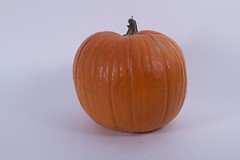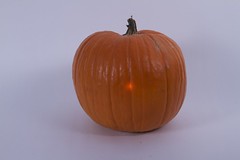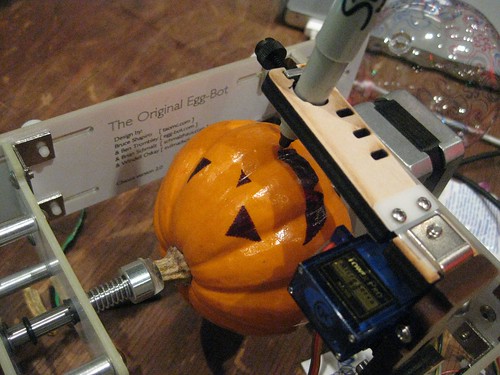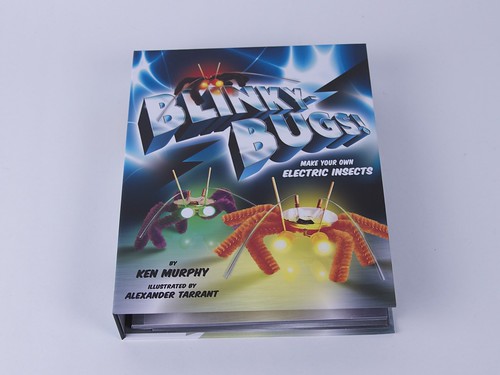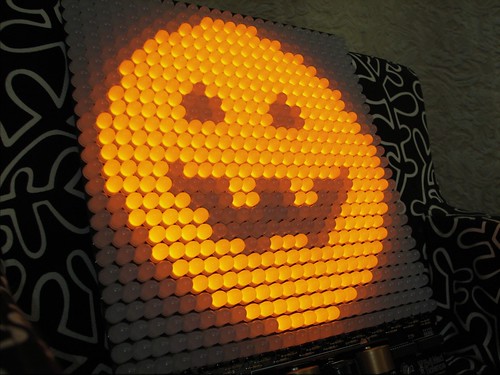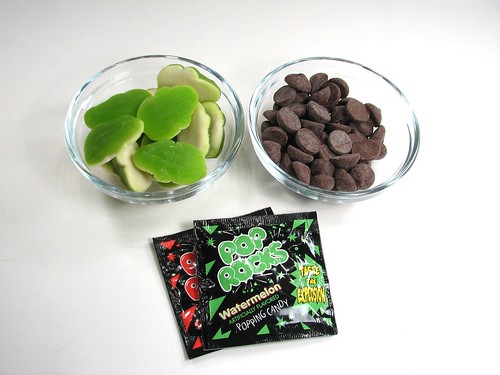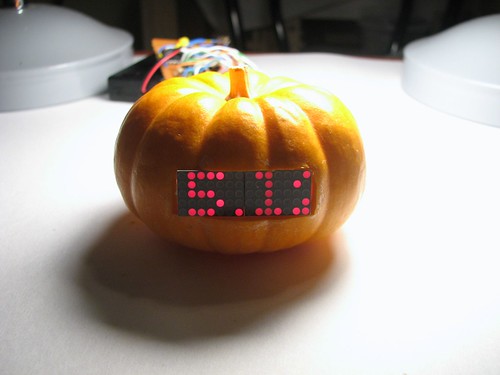Tag Archives: Halloween
A pumpkin that sleeps like a Mac
Here’s an neat idea for a jack-o’-lantern: Hide a single white LED just beneath the thin surface of the pumpkin. And program it with the same slow “breathing” effect that indicates sleep on Mac computers.
The result? A pumpkin that sleeps like a Mac. It’s actually quite striking, in part because the effect becomes invisible every few seconds. It’s also an easy microcontroller project: our demonstration video and build instructions follow. Continue reading A pumpkin that sleeps like a Mac
Printing on a strangely shaped egg
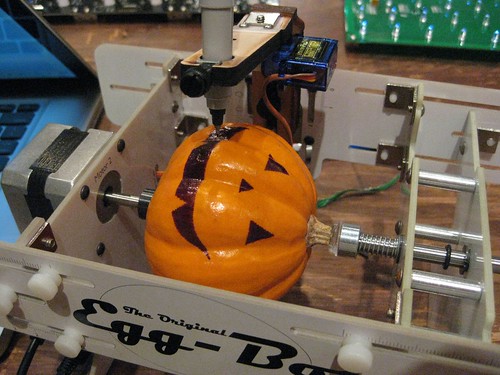
 One of those questions that keeps coming up about the Egg-Bot is, “Does the surface have to be perfectly smooth?” Or sometimes just, “Can you print on a golf ball?”
While we wouldn’t go so far as to say that you’ll have good luck printing on a tennis ball, it turns out that the surface doesn’t exactly have to be flat either. Golf balls certainly aren’t a challenge. And, as you can see above, you can even plot on strangely shaped “eggs,” so long as the surface is smooth enough that you can drag a marker along. Neat.
Update: We’ve posted some tips on using the Eggbot with pumpkins here.
One of those questions that keeps coming up about the Egg-Bot is, “Does the surface have to be perfectly smooth?” Or sometimes just, “Can you print on a golf ball?”
While we wouldn’t go so far as to say that you’ll have good luck printing on a tennis ball, it turns out that the surface doesn’t exactly have to be flat either. Golf balls certainly aren’t a challenge. And, as you can see above, you can even plot on strangely shaped “eggs,” so long as the surface is smooth enough that you can drag a marker along. Neat.
Update: We’ve posted some tips on using the Eggbot with pumpkins here.
You can find more pumpkin projects in our Halloween Project Archive.
Hacking the Blinkybugs Book
 Chronicle did a very nice job with it–the book itself comes out of the nifty sleeve that holds the kit and book together. The cartoon illustrations by Alexander Tarrant are very clear and there’s a nice assortment of accessories to go with the core hardware.
Chronicle did a very nice job with it–the book itself comes out of the nifty sleeve that holds the kit and book together. The cartoon illustrations by Alexander Tarrant are very clear and there’s a nice assortment of accessories to go with the core hardware.
 The bug circuit went together very easily. These little guys are super compact and self contained, which means they’re adaptable to all kinds of uses. And while putting them on pipe cleaner legs is seasonally appropriate, they’re a perfect fit for a mini-pumpkin. The first thing to do after gutting the gourd is to mark and cut the holes for the LED eyes. A 3/16″ bit turned by hand makes a hole that is just snug enough to hold a 5 mm LED firmly in place.
The bug circuit went together very easily. These little guys are super compact and self contained, which means they’re adaptable to all kinds of uses. And while putting them on pipe cleaner legs is seasonally appropriate, they’re a perfect fit for a mini-pumpkin. The first thing to do after gutting the gourd is to mark and cut the holes for the LED eyes. A 3/16″ bit turned by hand makes a hole that is just snug enough to hold a 5 mm LED firmly in place.
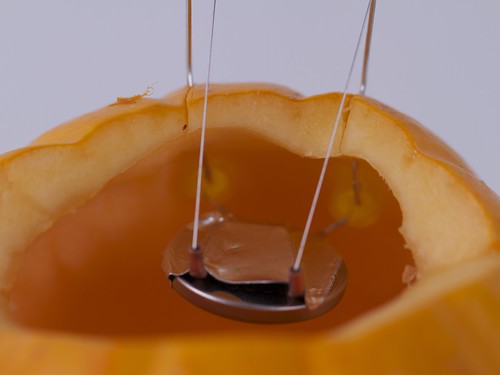 A couple of slits let the LED leads stick up through the body of the pumpkin where the antenna wires will be able to reach them.
A couple of slits let the LED leads stick up through the body of the pumpkin where the antenna wires will be able to reach them.
 Finally, the pumpkin lid is trimmed to allow the antenna wires to move freely.
Finally, the pumpkin lid is trimmed to allow the antenna wires to move freely.
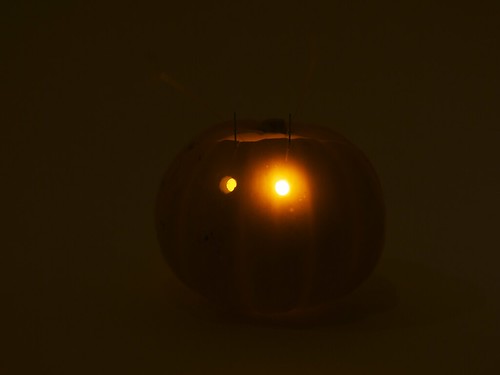
You can find more pumpkin projects in our Halloween Project Archive.
24 Hour Tombstones
Here is how to make your own cast concrete tombstones. These are easy, inexpensive, impressive and tough Halloween props, ready to spook in 24 hours.
Peggy-O-lantern
Lately we have been working on a new version of the PeggyDraw program, which is a program that lets you draw things that you want to display on the Peggy 2 for static images. The new version isn’t quite ready to show off this week, which is too bad because we like to put out our Peggies for halloween.
On the bright side, Mark Delp just sent in a program called bmp2peg that’s been added to the Peggy project at Google Code. It converts a (tiny) windows BMP file and generates an Arduino sketch that can run on the Peggy. (bmp2peg runs on windows, and also on linux if you recompile it, macs unknown thus far.) Both bmp2peg and the original cross-platform PeggyDraw can be used to put static images on the Peggy, or to generate static frames that you swap out in the code to build simple animations. The window-friendly pumpkin above was drawn as an image file, converted with bmp2peg, and installed on a Peggy 2 filled with orange LEDs.
Last year at halloween we took a different approach to the Peggy in the window. We took one filled with red LEDs, and every twenty seconds (or so) it would flash the letters “BOO” — huge and bright — and then go dark again. We took a little movie of this last year, showing how that works.
(The flickr video is embedded below — if you can’t see it, click through to see it.)
The video is very dark, but it’s accurate: our street really is that dark on Halloween. You have to walk slowly because you can’t see where the sidewalk is.
You can find more Halloween decor projects in our Halloween Project Archive.
Rovin Pumpkin
The Rovin’ Pumpkin’ is a simple robotic pumpkin, and a close cousin of the Snap-O-Lantern. Silently, it sits on your porch– camouflaged amongst the humble squashes.
After a minute, its green eyes start to glow, and it creeps… moving about one foot to the left… and stops. The eyes go dark again. It fades into the darkness. And it waits.
The Larson Scanner Kit

Today we’re releasing a new open-source project and kit, which is an updated approach to the “Larson Scanner.” The Larson scanner is named in honor of Glen A. Larson, the man responsible for producing both the original Battlestar Galactica and Knight Rider television shows, and consists of a set of red LEDs that scan back and forth.
Three years ago, we showed how to make a Cylon Jack-O-Lantern, in what has become one of our all-time most popular tutorials. The circuit for that project was based on a 555 timer, driving a 4017 decade counter, and has 6 pixels of resolution. To create the incandescent fading effect, we added low-pass transistor drivers. We also wrote up a version of that article for the 2007 Make Magazine Halloween special, which included a slightly nicer version of that same circuit.
And while it’s been popular, we’ve always had some nagging reservations about it, and in particular its battery life. This year, we decided to do something about it and made a much betterversion of the Larson Scanner, and so here it is:
But if we took the bones out…
Scariest Jack-o’-Lantern of 2008
Jack-o’-Lanterns are supposed to be scary, right? So here is our new one: it’s a mini pumpkin with a (tiny) scrolling LED stock ticker. Reprogrammable so you can update it every day with gloomy news from Wall Street.
Continue reading Scariest Jack-o’-Lantern of 2008






